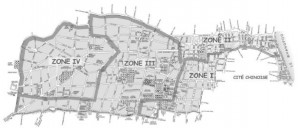
I have often wondered how zones of Old Shanghai were urbanised, of there was any planning at all. I recently encountered a document showing occupation zones of the French Concession in 1934. The document is in French and I have not been able to ascertain its origin or its author, but here is it for sharing with readers:
“Zones of population dispatch in the French Concession in 1934.
The dispatch of population was started from the beginning of the 20th century, continue following similar trends. From the cadaster study from 1934, the concentration of Chinese population is the highest near the Chinese city (Zone I). From the administration point of view, it is reserved for the native population; buildings of all styles can be erected, shops, factories in living quarters are mixed altogether.
Zone II is next to the business district (located in the International Settlement), occupied by many living quarters and Chines shops. The French municipality wanted to transform it into a ‘European City’ because of its size and it proximity with the business district but ambitions of the French municipality was never realized due to heavy cost of such a project. However, in order to smooth traffic and create more space between the buildings, it is decided to erect higher buildings in this area and avoid the anarchy of older constructions.
Zone III is occupied by shops and residence for the middle class. All constructions are allowed, but they must follow rules about aesthetic and keeping quiet around public facilities, including schools and hospital. Those exclude polluting or noise generating industries. European styles shops are favored on the street side, along with keeping space between buildings.
Zone IV is reserved for residential area and was further extended up to Xu Jia Hui. As a consequence, any factory not following “aesthetic rules” of the French municipality were prohibited so as to guarantee a western type of architecture and avoid pollution in this upper class area.”
It is interesting to compare this 1934 study with current urban development in Shanghai. Zone I is being totally transformed into a modern living area, along with the area of Zone III where Xin Tian Di is located. At the same time, Zone VI has kept most of its charm and is now often referred as “the Former French Concession”, when it actually is only a part of it.